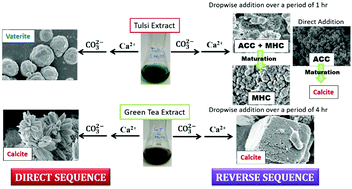Modulation of the CaCO3 phase and morphology by tuning the sequence of addition: an insight into the formation of monohydrocalcite†
Abstract
The ability of the organisms to tune themselves among various phases of biominerals with exquisitely beautiful morphologies is very appealing. This study aims to perform an in vitro study of the modulation of phases and the polymorphism of CaCO3, utilizing some naturally available and biological friendly templates. We successfully synthesized the metastable vaterite phase and the calcite phase with highly captivating and elegant floral morphology, viz., rose-like, daffodil-like and also spherical. These were accomplished using methanol and water extracts of tulsi and green tea, which were employed as templates during the in vitro crystallization of CaCO3. Interestingly, on reversing the sequence of addition of Ca2+ and CO32− ions, we could isolate two highly unstable phases, amorphous calcium carbonate and monohydrocalcite, with the assistance of the methanol extract of tulsi. By tuning the reaction conditions, we obtained a transition phase constituting the amorphous precursor and monohydrocalcite; this phase, on maturation, resulted in the complete transformation to monohydrocalcite.



 Please wait while we load your content...
Please wait while we load your content...